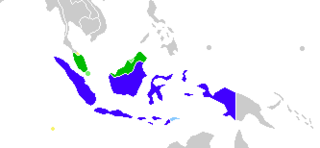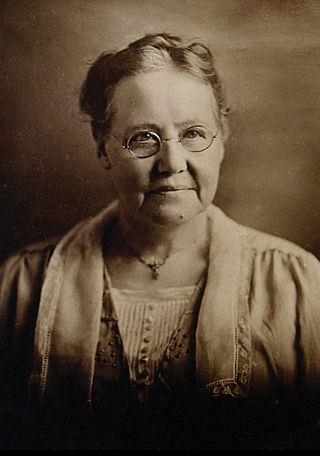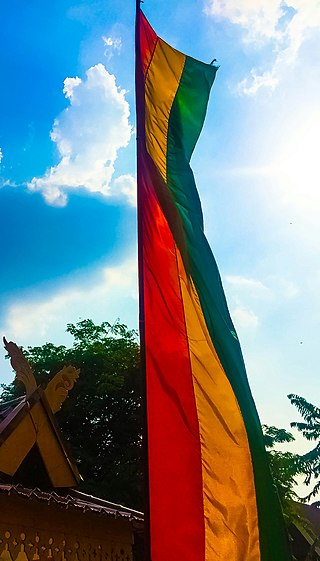Related Research Articles

The cicadas are a superfamily, the Cicadoidea, of insects in the order Hemiptera. They are in the suborder Auchenorrhyncha, along with smaller jumping bugs such as leafhoppers and froghoppers. The superfamily is divided into two families, the Tettigarctidae, with two species in Australia, and the Cicadidae, with more than 3,000 species described from around the world; many species remain undescribed.

Malay is an Austronesian language that is an official language of Brunei, Indonesia, Malaysia, and Singapore, and that is also spoken in East Timor and parts of Thailand. Altogether, it is spoken by 290 million people across Maritime Southeast Asia.

Camphor is a waxy, colorless solid with a strong aroma. It is classified as a terpenoid and a cyclic ketone. It is found in the wood of the camphor laurel, a large evergreen tree found in East Asia; and in the kapur tree, a tall timber tree from South East Asia. It also occurs in some other related trees in the laurel family, notably Ocotea usambarensis. Rosemary leaves contain 0.05 to 0.5% camphor, while camphorweed (Heterotheca) contains some 5%. A major source of camphor in Asia is camphor basil. Camphor can also be synthetically produced from oil of turpentine.

Orang Asli are a heterogeneous indigenous population forming a national minority in Malaysia. They are the oldest inhabitants of Peninsular Malaysia.

Batak is a collective term used to identify a number of closely related Austronesian ethnic groups predominantly found in North Sumatra, Indonesia, who speak Batak languages. The term is used to include the Karo, Pakpak, Simalungun, Toba, Angkola, and Mandailing ethnic groups. Which are related groups with distinct languages and traditional customs (adat).

Jakunpeople or Orang Ulu/Orang Hulu are an ethnic group recognised as Orang Asli of the Malay Peninsula in Malaysia.

The Kadazans are an ethnic group indigenous to the state of Sabah in Malaysia. They are found mainly in Penampang on the west coast of Sabah, the surrounding locales, and various locations in the interior.

Freada Kapor Klein is an American venture capitalist, social policy researcher and philanthropist. As a partner at Kapor Capital and the Kapor Center for Social Impact, she is known for efforts to diversify the technology workforce through activism and investments. Her 2007 book Giving Notice: Why the Best and the Brightest Leave the Workplace and How You Can Help Them Stay examines the reasons people have for leaving corporate America as well as the human and financial cost.

There are many Malay ghost myths, remnants of old animist beliefs that have been shaped by Hindu-Buddhist cosmology and later Muslim influences, in the modern states of Brunei, Indonesia, Malaysia, Singapore and among the Malay diaspora in neighbouring Southeast Asian countries. The general word for ghost is hantu, of which there exist a wide variety. Some ghost concepts such as the female vampires pontianak and penanggal are shared throughout the region. While traditional belief does not consider all ghosts as necessarily evil, Malaysian popular culture tends to categorise them all as types of evil djinn.

The Temuan people are a Proto-Malay ethnic group indigenous to western parts of Peninsular Malaysia. They can be found in the states of Selangor, Pahang, Johor, Negeri Sembilan and Malacca. The Temuans are classified as part of Orang Asli group according to the Malaysian government. They are also one of the largest and the most widespread of the Orang Asli ethnic groups.

The Senoi are a group of Malaysian peoples classified among the Orang Asli, the indigenous peoples of Peninsular Malaysia. They are the most numerous of the Orang Asli and widely distributed across the peninsula. The Senois speak various branches of Aslian languages, which in turn form a branch of Austroasiatic languages. Many of them are also bilingual in the national language, the Malaysian language.

Sophia Blackmore was an Australian Christian missionary. She founded the Fairfield Methodist Schools, and also Methodist Girls' School in Singapore. She was the first woman missionary sent by the Woman's Foreign Missionary Society of the Methodist Episcopal Church to Singapore. She also set up a boarding home for girls, supported the early Methodist Straits Chinese Christian work, published a Christian periodical in Baba Malay, and is closely associated with the founding of Kampong Kapor Methodist Church.
A bhoota or bhuta is a supernatural creature, usually the ghost of a deceased person, in the popular culture, literature and some ancient texts of the Indian subcontinent. Interpretations of how bhootas come into existence vary by region and community, but they are usually considered to be perturbed and restless due to some factor that prevents them from moving on. This could be a violent death, unsettled matters in their lives, or simply the failure of their survivors to perform proper funerals.

Malayisation or Malayization is a process of assimilation and acculturation, that involves acquisition or imposition of elements of Malay culture, in particular, Islam and the Malay language, as experienced by non-Malay populations of territories fully controlled or partially influenced by historical Malay sultanates and modern Malay-speaking countries. It is often described as a process of civilisational expansion, drawing a wide range of indigenous peoples into the Muslim, Malay-speaking polities of Maritime Southeast Asia. Examples of Malayisation have occurred throughout Asia including in Brunei, Cambodia, Indonesia, Malaysia, Singapore, and Sri Lanka.
Ambonese Malay or simply Ambonese is a Malay-based creole language spoken on Ambon Island in the Maluku Islands of Eastern Indonesia. It was first brought by traders from Western Indonesia, then developed when the Dutch Empire colonised the Maluku Islands and was used as a tool by missionaries in Eastern Indonesia. Malay has been taught in schools and churches in Ambon, and because of this it has become a lingua franca in Ambon and its surroundings.

Kampong Kapor Methodist Church is located on Kampong Kapor Road in Singapore's Little India district. The church is approximately 300 metres from Jalan Besar MRT station.

Margaretta Hare Morris was an American entomologist. Morris and the astronomer Maria Mitchell were the first women elected to the American Association for the Advancement of Science in 1850. She was also the second woman elected to the Academy of Natural Sciences of Philadelphia in 1859, after Lucy Say.

Old Pahang Kingdom was a historical Malay polity centred in the Pahang region in the east coast of Malay Peninsula. The polity appeared in foreign records from as early as the 5th century and at its height, covered much of modern state of Pahang and the entire southerly part of the peninsula. Throughout its pre-Melakan history, Pahang was established as a mueang or naksat of some major regional Malayic mandalas including Langkasuka, Srivijaya and Ligor. Around the middle of the 15th century, it was brought into the orbit of Melaka Sultanate and subsequently established as a vassal Muslim Sultanate in 1470, following the coronation of the grandson of the former Maharaja as the first Sultan of Pahang.
Bisan is a female nature spirit or deity widely venerated among the Malay and Jakun natives.